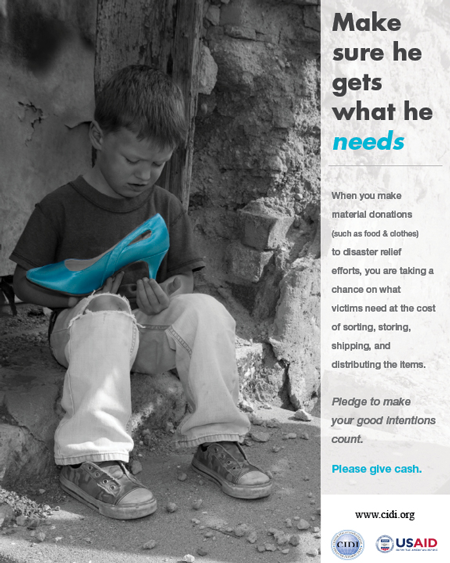Yes, Cash is Best. Now when will USAID follow its own advice?
These two posters are finalists in a student contest to create public service announcements that tell Americans why giving cash in emergencies is better than giving goods like food, bottled water, or used clothes. (Hat tip to Saundra Schimmelpfennig).
The contest guidelines, provided by the Center for International Disaster Information (CIDI), are very clear on why they require entrants to focus on the simple message that giving money is the best way to help. They give three reasons, with which many Aid Watch readers are already familiar:
1) Financial contributions are easily convertible to meet the international disaster victims' specific and immediate needs;
2) Cash donations are more efficient, allowing purchases to be made at a bulk discount, at a lower transportation cost…
3) Cash donations go directly to the disaster site, allowing for exact purchases of what is needed most urgently and stimulating local economies. Other donations, such as products/goods, take time and money to transport, rarely meet victims' urgent needs, often interfere with professional relief efforts and frequently clash with cultural norms.
The videos and posters from the student finalists are here. The winners, announced tomorrow, get a cash prize and will have their work featured in CIDI’s national public education campaign. Now in its fifth year focusing on the very same message, the contest is funded by USAID, a fact which should also be obvious from the USAID logo on every entry.
The US is globally one of the worst offenders of aid tying, whereby US aid is “tied” to the purchase of American goods and services (a useful primer is here). While the percentage of aid that the US reports as tied is now falling thanks to improvements in reporting procedures as well as increases in implicitly untied programming through the Millennium Challenge Corporation and PEPFAR, the US still ranked a sad 19th out of 23 rich country donors in 2008, losing to even Italy, and edging out only Spain, Greece, Korea and Portugal.
In particular, American legislation requires that most US food aid be bought in the US, processed and packed by US firms, and shipped on US-registered vessels. As a result, only about 40 percent of the money that the US spends on food aid actually goes to buying food, and that food is often tragically slow to arrive. When proposals to change these archaic laws have come before the US Congress, they have largely been shouted down or diluted. Canada successfully shifted to a cash-only system in 2008; the US could and should do the same.
As the smart giving movement gains steam among individual donors, aren't we ready to end these wasteful practices institutionalized in US law and carried out by the world's largest bilateral aid agency? Only then would USAID finally be able to follow its own good advice: Cash is best.
 From Aid to Equality
From Aid to Equality


